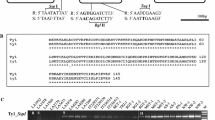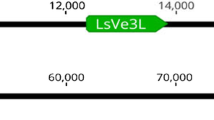Abstract
Tomato (Lycopersicon esculentum) cultivars that contain the Pto bacterial resistance locus also exhibit sensitivity to fenthion, an organophosphorous insecticide. Resistance to Pseudomonas syringae pv. tomato (Pst) encoded by the Pto gene and sensitivity to fenthion cosegregate in large F2 populations and were apparently introgressed together into tomato from the wild species Lycopersion pimpinellifolium. In order to isolate the genes responsible for these two phenotypes and to study their molecular basis, a multistep map-based cloning project was initiated. A closely linked RFLP marker was used to isolate a yeast artificial chromosome (YAC) clone that spanned the Pto region. Transcribed sequences within the Pto region were identified by isolating cDNA clones that hybridized to the YAC clone. Transformation of candidate cDNA clones into a Pst-susceptible, fenthion-insensitive tomato line succeeded in identifying a cDNA conferring Pst resistance and a separate cDNA conferring sensitivity to fenthion. The cDNA clones represent members of a tandemly repeated gene family and encode putative serine-threonine protein kinases. The role of these kinases in recognizing a signal from Pst or the fenthion molecule and in activating the plant response is currently being investigated.
Similar content being viewed by others
Abbreviations
- Pst :
-
Pseudomonas syringae pv. tomato
- RAPD:
-
random amplified fragment polymorphism
- RFLP:
-
restriction fragment length polymorphism
- YAC:
-
yeast artifical chromosome
References
Altschul, S.F., W. Gish, W. Miller, E.W. Myers & D.J. Lipman, 1990. Basic local alignment search tool. J. Mol. Biol. 215: 403–410.
Bennetzen, J.L. & S.H. Hulbert, 1992. Organization, instability, and evolution of plant disease resistance genes. Plant Mol. Biol. 20: 575–577.
Buss, J.E., M.P. Kamps, K. Gould & B.M. Sefton, 1986. The absence of myristic acid decreases membrane binding of p60src but does not affect tyrosine protein kinase activity. J. Virol. 58: 468–474.
Chang, C., G.E. Schaller, S.E. Patterson, S.F. Kwok & E.M. Meyerowitz, 1992. The TMK1 gene from Arabidopsis codes for a protein with the structural and biochemical characteristics of a receptor protein kinase. Plant Cell 4: 1263–1271.
Ellingboe, A.H., 1976. Genetics of host-parasite interactions. In: Heitefuss, R. & P.H. Williams (Eds.), Encyclopedia of Plant Pathology, New Series, Vol 4: Physiological Plant Patholog, pp. 761–778. Springer-Verlag, Heidelberg, FDR.
Flor, H.H., 1971. Current status of the gene-for-gene concept. Ann. Rev. Phytopathol. 9: 275–296.
Gabriel, D.W., A. Burges & G.R. Lazo, 1986. Gene-for-gene interactions of five cloned avirulence genes from Xanthomonas campestris pv malvacearum with specific resistance genes in cotton. Proc. Natl. Acad. Sci. USA 83: 6415–6419.
Hanks, S.K., A.M. Quinn & T. Hunter, 1988. The protein kinase family: Conserved features and deduced phylogeny of the catalytic domains. Science 241: 42–52.
Hulbert, S.H. & J.L. Bennetzen, 1991. Recombination at the Rp1 locus of maize. Mol. Gen. Genet. 226: 377–382.
Jones, D.A., M.J. Dickinson, P.J. Balint-Kurti, M.S. Dixon & J.D.G. Jones, 1993. Two complex resistance loci revealed in tomato by classical and RFLP mapping of the Cf-2, Cf-4, Cf-5 and Cf-9 genes for resistance to Cladosporium fulvum. Mol. Plant-Microbe Interactions 6: 341–348.
Keen, N.T. & R.I. Buzzel, 1991. New disease resistance genes in soybean against Pseudomonas syringae pv. glycinea: Evidence that one of them interacts with a bacterial elicitor. Theor. Appl. Genet. 81: 133–138.
Laterrot, H., 1985. Susceptibility of Pto plants to Lebaycid insecticide: a tool for plant breeders? Tomato Genet. Coop. Rep. 35: 6.
Laterrot, H. & A. Moretti, 1989. Linkage between Pto and susceptibility to Fenthion. Tomato Genet. Coop. Rep. 39: 21–22.
Martin, G.B., M.W. Ganal & S.D. Tanksley, 1992. Construction of a yeast artificial chromosome library of tomato and identification of cloned segments linked to two disease resistance loci. Mol. Gen. Genet. 233: 25–32.
Martin, G.B., M.C.de Vicente & S.D. Tanksley, 1993a. High resolution linkage analysis and physical characterization of the Pto bacterial resistance locus in tomato. Mol. Plant-Microbe Interactions 6: 26–34.
Martin, G.B., S.H. Brommonschenkel, J. Chunwongse, A. Frary, M.W. Ganal, R. Spivey, T. Wu, E.D. Earle & S.D. Tanksley, 1993b. Map-based cloning of a protein kinase gene conferring disease resistance gene in tomato. Science 262: 1432–1436.
Martin, G.B., A. Frary, T. Wu, S.H. Brommonschenkel, E.D. Earle & S.D. Tanksley, 1994. A member of the Pto gene family confers sensitivity to fenthion (in press).
Pitblado, R.E. & B.H. MacNeill, 1983. Genetic basis of resistance to Pseudomonas syringae pv. tomato in field tomatoes. Can. J. Plant Pathol. 5: 251–255.
Pitblado, R.E., B.H. MacNeill & E.A. Kerr, 1984. Chromosomal identity and linkage relationships of Pto, a gene for resistance to Pseudomonas syringae pv. tomato in tomato. Can. J. Plant Pathol. 6: 48–53.
Ronald, P.C., J.M. Salmeron, F.M. Carland & B.J. Staskawicz, 1992. The cloned avirulence gene avrPto induces disease resistance in tomato cultivars containing the Pto resistance gene. J. Bacteriol. 174: 1604–1611.
Salmeron, J.M., S.J. Barker, F.M. Carland, A.Y. Mehta & B.J. Staskawicz, 1994. Tomato mutants altered in bacterial disease resistance provide evidence for a new locus controlling pathogen recognition. Plant Cell 6: 511–520.
Staskawicz, B., J.D. Dahlbeck & N.T. Keen, 1984. Cloned avirulence gene of Pseudomonas syringae pv. glycinea determines racespecific incompatibility on Glycine max (L.) Merr. Proc. Natl. Acad. Sci. USA 81: 6024–6028.
Stein, J.C., B. Howlett, D.C. Boyes, M.E. Nasrallah & J.B. Nasrallah, 1991. Molecular cloning of a putative receptor protein kinase gene encoded at the self-incompatibility locus of Brassica oleracea. Proc. Natl. Acad. Sci. 88: 8816–8820.
Author information
Authors and Affiliations
Rights and permissions
About this article
Cite this article
Martin, G.B. Analysis of the molecular basis of Pseudomonas syringae pv. tomato resistance in tomato. Euphytica 79, 187–193 (1994). https://doi.org/10.1007/BF00022518
Issue Date:
DOI: https://doi.org/10.1007/BF00022518




